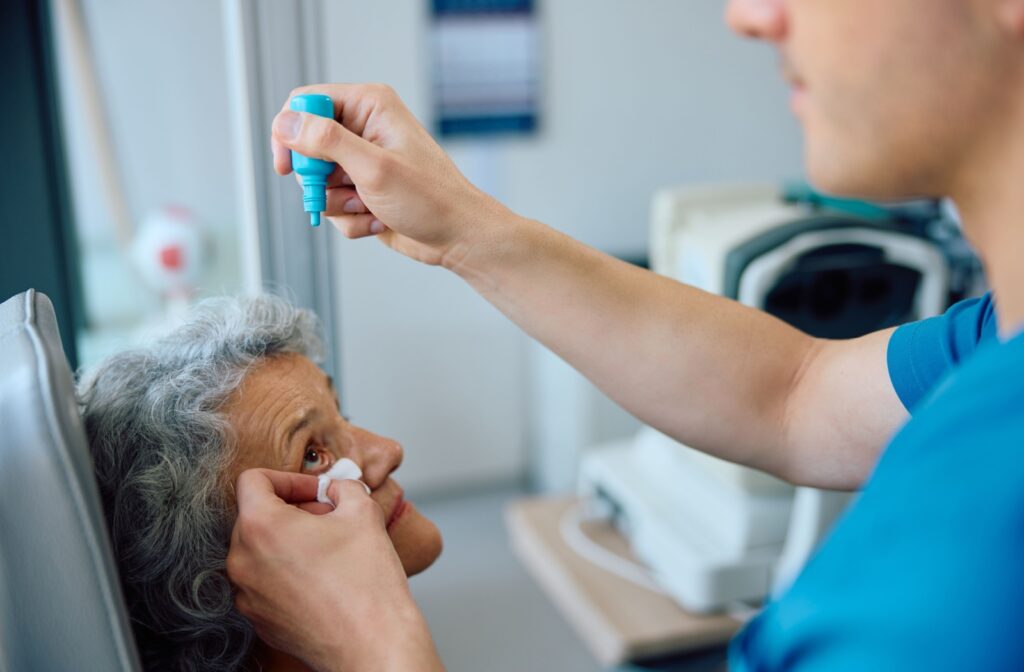Staying on top of your routine eye exams is a responsible step toward maintaining good vision and overall eye health. Nothing screams “responsible” quite like researching ahead of time, trying to figure out if getting behind the wheel and driving after this appointment is safe.
The key factor in whether you can drive after an eye exam is whether we dilate your pupils.
We sometimes use special eye drops to enlarge your pupils, making it easier for us to see fine details in the eye’s internal structure. These drops, however, come with side effects that make driving after the appointment unsafe.
Not everyone needs a dilated eye exam. If you’re unsure whether this applies to you, please don’t hesitate to connect with our team.
What Happens During an Eye Exam?
Just as you visit your family doctor or dentist for routine checkups, your eyes can benefit from and require the same level of attention and care.
Routine eye exams benefit everyone, even if you don’t need corrective lenses.
Beyond monitoring your vision, these comprehensive evaluations allow your eye doctor to assess the overall eye health of your eyes, making it easier to detect eye concerns (and even some general health conditions) before symptoms manifest and the disease progresses.
As a quick overview, routine eye exams often include:
- Vision testing to evaluate your prescription
- Eye pressure testing to check for conditions like glaucoma
- A close look at your retina and optic nerve using specialized tools
One specific part of the exam that patients often ask about is pupil dilation. This allows your optometrist to see the back of your eye in greater detail, making it easier to detect concerns like retinal detachment or signs of disease.
A Closer Look at the Dilated Eye Exam
Eye dilation involves special eye drops that temporarily widen (or dilate) your pupils. This lets more light enter the eye, giving your eye doctor a much better view of your retina, optic nerve, and blood vessels, making it easier to identify any abnormal changes.
A dilated eye exam is especially beneficial for people at risk for certain eye conditions or those with underlying health concerns. This includes:
- Family history of eye disease: Conditions such as glaucoma, macular degeneration, or retinal detachment can have hereditary links. A dilated exam allows for a more thorough evaluation of the retina and optic nerve, helping to detect early signs of these issues.
- People with diabetes or high blood pressure: Both conditions can lead to complications like diabetic retinopathy or hypertensive retinopathy. Dilating the eyes gives optometrists a clearer view of any damage to retinal blood vessels.
- Sudden vision changes: If you’re noticing blurriness, floaters, or flashes of light, a dilated exam can help uncover the root cause of these symptoms.
- Older adults: The risk for age-related eye conditions, such as cataracts or macular degeneration, increases with age. A dilated exam provides a complete assessment crucial for managing these changes.
Dilation Side Effects
Dilation is an incredibly valuable tool in vision care, but it does come with temporary side effects, which are completely normal:
- Blurry vision at near distances (sometimes at far distances too)
- Light sensitivity from your pupil size increases
- Difficulty focusing, especially on screens or small text
These effects can last anywhere from 4 to 6 hours, though it may take longer for some people.

Can You Drive After an Eye Dilation?
The short answer is no.
Just because you can drive after, doesn’t mean we recommend getting behind the wheel. It’s always better to err on the side of caution, especially if you have never had a dilation.
Your ability to drive after eye dilation hinges on how sensitive your eyes are to the drops and how quickly your vision bounces back. For most people, dilation causes temporary blurry vision and light sensitivity, making driving uncomfortable, challenging, and unsafe.
If you know your eyes will be dilated during your visit, here are a few tips to make the process easier:
- Bring UV protective sunglasses: Your eyes will be very light-sensitive after dilation. Wraparound-style sunglasses or those with polarized lenses will help reduce glare, keeping you comfortable.
- Arrange a ride: Ask a family member or friend to drive you home, or consider using a rideshare service like Uber or Lyft.
- Plan your day accordingly: It can take up to 6 hours for your eyes to return to normal. Avoid scheduling important meetings or tasks that require sharp, close-up vision.
Dilation Alternatives
Not all eye exams include dilation. With advancements in diagnostic tools like Fundus Photography and OCT scans, we can take clear images of the eye’s internal structures, which are sufficient for most people.
Dilation becomes valuable if we’re monitoring for specific and minor details. More incoming light enhances image quality, making it easier to detect even subtle changes.
With that said, if you’re uneasy about having a dilated eye exam or need to schedule this visit on another day, please inform our team. We’re here to support you in any way we can to make vision care comfortable for you.
Navigating the Road Ahead
Just because you can drive after an eye exam doesn’t necessarily mean you should. Protecting your vision and eye health is not distinct from keeping yourself and others on the road safe.
Driving after an eye exam is more than okay if we don’t dilate your eyes. If you think a dilated eye exam might be in the cards for you, plan ahead or connect with our Total Vision Hercules team for extra guidance.
See the world more clearly, and stay on top of your visual health by booking a routine eye exam today.



